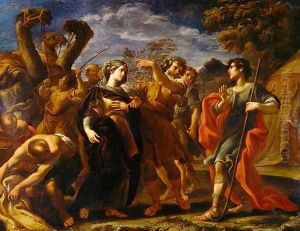Ricci Paintings
Sebastiano Ricci was an Italian painter of the late Baroque period, born in 1613 in Belluno, a small town in the Venetian Republic. He is considered one of the forerunners of the Rococo style, which flourished in the 18th century. His work was characterized by dynamic composition, vibrant color, and a facility in depicting light effects, which would become hallmarks of the Rococo aesthetic. Ricci's early life was marked by apprenticeships in Venice, where he absorbed the rich artistic traditions of the Venetian school, particularly the influence of masters such as Paolo Veronese and Tintoretto.
Throughout his career, Ricci traveled extensively across Italy, working in cities like Florence, where he was influenced by the works of the Baroque painters there, and Rome, where he studied the ancient ruins and the works of Renaissance masters. His travels and experiences contributed to the development of his distinctive style, which blended elements of the Venetian tradition with the grandeur and drama of the Baroque.
In the latter part of his career, Ricci spent time in England, where he was commissioned to create works for the royal court and the aristocracy. His time in England was successful, and he produced several notable works, including murals and altarpieces. However, personal scandals and financial difficulties often plagued him, leading to various periods of hardship throughout his life.
Sebastiano Ricci's contribution to the development of the Rococo style, especially in his later works, was significant. His use of light, color, and fluid forms influenced many artists of the 18th century. Despite facing personal and professional challenges, Ricci's work remained highly sought after during his lifetime, and he is remembered today as a pivotal figure in the transition from the Baroque to the Rococo. He passed away in 1687 in Venice, leaving behind a legacy that would influence the direction of European art for decades to come.
